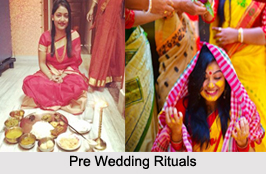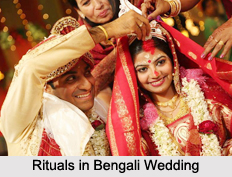 Rituals in Bengali Wedding are quite long and elaborate. There are a number of rituals and ceremonies that take place during the wedding. The blowing of the conch shell and ululation by the women gathered at the wedding venue are most characteristic of a Bengali marriage. Shehnai recital played by live musicians or else played over a music system adds to this symphony. The pre-wedding and post-wedding rituals provide ample opportunity to the loved ones to enjoy with each other. However, the traditional Bengali rituals are quite meaningful and interesting.
Rituals in Bengali Wedding are quite long and elaborate. There are a number of rituals and ceremonies that take place during the wedding. The blowing of the conch shell and ululation by the women gathered at the wedding venue are most characteristic of a Bengali marriage. Shehnai recital played by live musicians or else played over a music system adds to this symphony. The pre-wedding and post-wedding rituals provide ample opportunity to the loved ones to enjoy with each other. However, the traditional Bengali rituals are quite meaningful and interesting.
Pre-Wedding Rituals
Pre-wedding rituals start with "Vridhi Puja", which is done to remember the ancestors of the bride and the groom. This is followed by "Dodhi Mangal" ceremony, wherein at dawn on the day of marriage 7 married ladies adorn the bride"s hands with the traditional bangles "Shakha and Paula" and feed her a meal of curd and rice, the only meal for the day. Next is the "Gaye Holud" ritual, in which the bride is sent gifts by her in laws along with turmeric paste. This is applied on the groom first and then the bride to brighten up the complexion and makes skin glow.
Wedding Rituals
 The wedding day rituals begin with welcoming the "Bor Jatri" i.e., the groom and the members of the groom"s house as well as his friends. An elderly female relative welcomes the groom with "Baran Dala". It is a plate which is first touched to the forehead of the groom, then touched to the ground and then again touched to his forehead. After this, the groom is given sweets and sherbet. As he enters the house, rose water is sprinkled over him. The next is the "Shubho Drishti" ritual, wherein the bride and the groom see each other for the first time.
The wedding day rituals begin with welcoming the "Bor Jatri" i.e., the groom and the members of the groom"s house as well as his friends. An elderly female relative welcomes the groom with "Baran Dala". It is a plate which is first touched to the forehead of the groom, then touched to the ground and then again touched to his forehead. After this, the groom is given sweets and sherbet. As he enters the house, rose water is sprinkled over him. The next is the "Shubho Drishti" ritual, wherein the bride and the groom see each other for the first time.
This is followed by "Mala Badal" ceremony, wherein they exchange garlands. The most important rituals on the wedding day are "Saat Paak", during which the bride is seated on a wooden plank and lifted by her brothers. Thereafter she is taken around the groom 7 times, which signifies their union. In "Sampradan" ritual the paternal and maternal uncles of the bride, give her away to the groom. After this, the "Yajna" ritual takes place where the bride and groom sit in front of the sacred fire and chant mantras after the priest. Agni, the fire god is made the divine witness to the marriage. Lastly the "Sindoor Daan" is done where the groom applies Sindoor or vermilion (a symbol of marriage worn by Hindu women thereafter) on the bride"s hair-parting. The bride then covers her head with a new saree offered by the groom.
Post-Wedding Rituals
After the wedding the "Basar Ghar" ceremony takes place, wherein the newly wed couple is treated warmly and served delicious food. On the next morning the "Bashi Biye" ritual takes place in which the groom again applies vermilion on the bride"s forehead. After this, the "Bidaai" ceremony is held and the bride leaves with the groom for her marital abode. The first ceremony at groom"s place is "Bou Baran", which is a welcome ceremony for the bride. The bride submerges her feet in a plate containing lac dye and milk and enters the house, leaving imprints. Then come "Kaal Ratri" where the newly wed couples are separated for the night, probably to get a refreshing sleep and prepare for the next day"s final wedding ceremony. The next is the "Bou Bhaat" ceremony. It is held as the bride eats her first meal in her husband"s house. The wedding ceremony ends with "Phool Shojya" where the couple is adorned with flowers and are left together alone in their room to enjoy conjugal bliss on a bed laid with flowers.

















